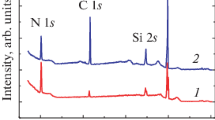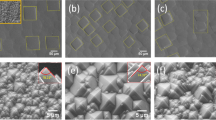Abstract
Surface sensitive techniques, the field-modulated surface photovoltage, photoluminescence measurements, atomic force microscopy and scanning electron microscopy, were employed to yield detailed information on the influence of wet-chemical treatments on the preparation induced microroughness and electronic properties of wet-chemically passivated Si(111) substrates with special surface morphology. Stepped substrates with evenly distributed atomically flat terraces were prepared and passivated by thin oxide layers, which were used as a starting point for the subsequent H-termination after long storage in air. It was shown that their surface morphology and electronic properties do not degrade. Applying this preparation method to solar cell substrates with randomly distributed Si(111) pyramids, we achieved significantly lower densities of surface states and reduced recombination loss at a-Si:H/c-Si interfaces, compared with conventional pretreatments. The surface microroughness, the density of rechargeable states and the resulting recombination loss on a-Si:H/c-Si heterojunctions were found to be mainly influenced by two steps of surface pretreatment: firstly, the wet-chemical smoothing procedure of structured substrates and, secondly, the removal of native and wet-chemical oxides during the final etching in HF- or NH4F- containing solutions.

After wet-chemical oxidation in H2SO4/H2O2 and storage in air






Similar content being viewed by others
References
Chabal YA, Higashi GS, Raghavachari K, Burrows VA (1989) J Vac Sci Technol A 7(3):2104
Okorn-Schmidt HF (1999) IBM J Res Dev 43:315
Noguchi H, Adachi S (2005) Appl Surf Sci 246:139
Yang SK, Peter S, Takoudis CG (1994) J Appl Phys 76 (7):4107
Angermann H, Henrion W, Rebien M, Röseler A (2004) Appl Surf Sci 235:322
Angermann H, Henrion W, Rebien M, Röseler A (2003) Solid State Phenomena 92:179
Angermann H (2002) Anal Bioanal Chem 374:676
Rappich J, Timoshenko VY, Dittrich T (1997) J Electrochem Soc 144:493
Timoshenko VY, Petrenko AB, Stolyarov MN, Dittrich T, Füssel W, Rappich J (1999) J Appl Phys 85(2):4171
Laades A (2005) PhD thesis, Technische Universität Berlin
Heilig K (1968) Exp Tech Phys 14:135
Heilig K (1984) Solid State Electron 27(4):395
Kern WJ (1990) Electrochem Soc 137(6):1987
Maydell Kv, Conrad E, Schmidt M (2006) Prog Photovolt 14:289
Jablonovitch E, Allara DL, Chang CC, Gmitter T, Bright TB (1986) Phys Rev Lett 57:249
Weinberger BR, Peterson GG, Eschrich TC, Krasinski HA (1986) J Appl Phys 60:3232
Allongue P, Villeneuve CH, Morin S, Boukherroub R, Wayner DDM (2000) Electrochimica Acta 45:4591
Wade CP, Chidsey CED (1997) Appl Phys Lett 71:1679.
Fukidome H, Matsumura M (1998) Appl Surf Sci 130:146
Rauscher S, Dittrich T, Aggour M, Rappich J, Flietner H, Lewerenz H-J (1995) Appl Phys Lett 66:3018
Henrion W, Rebien M, Angermann H, Röseler A (2002) Appl Surf Sci 202:199
Pointdexter EH, Geraldi GJ, Rueckel ME, Caplan PJ, Johnsohn NM, Biegelsen DK (1984) J Appl Phys 56:2844
Flietner H (1995) Mater Sci Forum 73:185–188
Lenahan PM, Dressendorfer PV (1984) J Appl Phys 55:3495
Pointdexter EH (1984) J Appl Phys 56:2844
Angermann H, Rappich J, Maydell K, Conrad E, Sieber I, Schaffarzik D, Schmidt M In: Hoffmann W et al (eds) 21st European photovoltaic solar energy conference, Dresden, Germany, 4–8 Sept 2006, contribution no 2CV.3.41, p 895
Schmidt M, Korte L, Laades A, Stangl R, Schubert C, Angermann H, Conrad E, Maydell K (2007) Thin Solid Films 515:7475
Timoshenko VY, Rappich J, Dittrich T (1997) Jpn J Appl Phys 36:L58
Timoshenko VY, Petrenko AB, Dittrich T, Füssel W, Rappich J (2000) Thin Solid Films 364:196
Angermann H, Korte L, Rappich J, Schaffarzik D, Conrad E, Sieber I, Schmidt M (2007) In: Proceedings of the 22nd European photovoltaic solar energy conference Milan, Italy, 3–7 Sept 2007
Author information
Authors and Affiliations
Corresponding author
Rights and permissions
About this article
Cite this article
Angermann, H., Rappich, J., Sieber, I. et al. Smoothing and passivation of special Si(111) substrates: studied by SPV, PL, AFM and SEM measurements. Anal Bioanal Chem 390, 1463–1470 (2008). https://doi.org/10.1007/s00216-007-1738-5
Received:
Revised:
Accepted:
Published:
Issue Date:
DOI: https://doi.org/10.1007/s00216-007-1738-5




